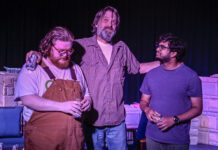Kent Buehler is not afraid to get his hands dirty. As an archeologist, he’s searched for information about ancient cultures, but that’s not all he’s digging for these days.
Buehler and his Crime Scene Archaeology Recovery Group are lending their expertise to law officers as they assist in uncovering human remains at crime scenes. That work has taken them all over the state and involves everything from excavating scattered surface skeletal remains to bodies buried under hundreds of pounds of concrete.
“If you think about excavating a buried body, who has more experience in doing that than archeologists?” Buehler asks.
While the work is always challenging and often unpleasant and time consuming, Buehler says it’s a job that needs to be done.
“We do it because there is a need for it,” Buehler says. “It can make a difference in the outcome of a criminal case. And if nothing else, it helps to recover the remains of a loved one who, in some cases, may have been missing many, many years. And it’s a good feeling to help with that, and it’s a good feeling to help put a bad guy away.”
The group, which began working cases a few years ago, also includes Dr. Heather Ketchum, a forensic entomologist, Angela Berg, an anthropologist with a medical examiner’s office and graduate student at OU, as well as other anthropology students.
Buehler says the group has developed a strong relationship with law enforcement across the state, but believes many still are not familiar with their services.
“There is a need for this kind of work and it’s something that law enforcement is just not exposed to, nor do they have the expertise and the knowledge to deal with this,” Buehler says.
While helping on crime scenes is something new for Buehler and his team, forensic science is not. In the late 1970s, the Oklahoma Archaeological Survey at the University of Oklahoma became among the first in the country to delve into the subject, when they introduced courses in crime scene archeology.
The department primarily worked with the Oklahoma City Police Department, teaching law officers the principles and techniques of forensic archeology. Buehler joined the staff in 1987 and was later chosen to head the program in 1996.
After a brief hiatus, the program was reintroduced a few years ago. During the few short years the group has been around, they have helped with cases across the state. The majority have been in the Oklahoma City and Tulsa metro areas, but the group assists rural police departments as well.
Buehler says the average case involves about two-and-a-half workdays, but they have spent as many as 21 days on a single case.
“During that case we were looking for a grave over a large area with nothing to indicate where it was,” he says. “We tried ground penetrating radar and ultimately we did not find anything.”
Each crime scene presents a different set of challenges for Buehler and his team, but it is not all that different from an archeological dig.
“We use some high-tech equipment like remote sensing tools, but there can be a lot of physical labor when we do hand excavation,” Buehler says. “You need to be flexible and figure out what techniques will work best. Sometimes we’re looking for a grave in large area and do not have any information about where it might be.”
When he’s not fighting crime, Buehler works at the Oklahoma Archeological Survey, where he manages the lab, conducts research, teaches and works with the State Historic Preservation and Oklahoma Historical Society to preserve and protect cultural resources within the state.

























